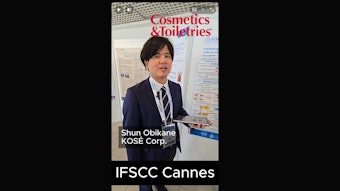It has been extensively reported that particles of submicron dimensions can penetrate the stratum corneum (SC);1-4 however, this remains a controversial area and was recently refuted in the case of solid nanoparticles, e.g. zinc oxide.5 In vivo studies by Lademan et al.6 also demonstrated that particles having dimensions of greater than 40 nm fail to penetrate the intact SC through cellular or paracellular pathways, and only appear to penetrate via a follicular route.7 Yet other contradictory work warrants the further investigation8 of particles < 100 nm into the SC; for instance, ex vivo skin studies have shown that rigid metallic nanoparticles of < 10 nm can penetrate the SC.9 In addition, elastic phospholipid vesicles of approximately 100 nm have been shown in vivo to penetrate the SC, to a greater extent than nonelastic vesicles of similar dimensions.10 This suggests a role for elastic nanostructures with dimensions on the order of 10 nm.
Therefore, based upon the structure of naturally occurring high-density lipoproteins (HDL), nanoparticles of reduced size and controlled dimensions were developeda to topically deliver oil-soluble cosmeceuticals and active agents into the stratum corneum (SC). These particles range from 10 to 40 nm, much smaller than standard carriers such as liposomes (50 to > 1,000 nm).
In the present article, the authors investigate the characteristics of these particles, including the use of temperature to control their size and integrity, as monitored by Dynamic Light Scattering (DLS).11 In addition, a novel near-infrared chemical imaging technique (NIR-CI) was adopted to analyze a 1-cm2 section of tape-stripped skin to assess the penetration of the particles and further evaluate their delivery capabilities.12, 13 Their ability to respond to the environment modulates their penetration into the SC and consequential delivery of ingredients, as will be shown.
Solubilizing Nanoparticles
The nanoparticles under investigation are composed of a phospholipid membrane core conformed by a responsive chaperone molecule that is either a polymer or a surfactant of the correct canonical shape (see Figure 1).14 This chaperone molecule assembles15 to entrap the phospholipid in either a discoid bilayer or a spherical form (see Figure 2). The size and shape of the chaperone molecule is a critical factor in defining the overall nanoparticle size and stability.
Since the nanoparticles are designed to mimic naturally occurring lipo- proteins, they may be transported within the aqueous milieu of the interstitial fluid. The application proposed here is for the encapsulation of hydrophobic or oily molecules such as cosmetic actives within the hydrophobic core of the nanoparticles. In addition, the hydrophobic particle core acts to protect labile active principal ingredients (API) from the damaging effects of reactive oxygen species (ROS) present in the surrounding aqueous milieu.
Particle size: As noted, particle size is a critical parameter in achieving penetration into the skin. Hydrophilic channels within the SC are on the order of 2 nm16 and evidence suggests that liposomes greater than 50 nm in diameter will simply remain on the skin’s surface;17, 18 in addition, micelles below 5–10 nm are considered too unstable to effectively transport active ingredients through the SC17 and maintain their structural integrity. As noted, the nanoparticles described are within the range of 10 nm to 40 nm. In addition, they are highly flexible, which allows them to wedge into the elastic hydrophilic pores of the SC, thereby accumulating within outer layers to form a reservoir of active materials. Alternatively, they may accumulate in the follicular pathways located around the hair shaft and penetrate the skin via that route.7, 19, 20
Temperature sensitivity: When the chaperone molecule used is a surfactant with the correct shape, it is possible to create nanoparticles that are sensitive to temperature since the surfactant interacts with phospholipids in a manner that is dependent upon its HLB value. For example, polyoxyethylene sorbitan monolaurate, or polysorbate 20, is a chaperone molecule that can produce temperature-sensitive nanoparticles in combination with lecithins.
At a critical temperature, known as the cloud point (CP), the surfactant/ phospholipid complex begins to disassociate in response to weakened surfactant-phospholipid interactions. Any additional increase in temperature accelerates this disassociation until full particle breakdown occurs, releasing the bound phospholipid together with any bound APIs, and resulting in the formation of a conventional macroscopic emulsion. The nanoparticle system therefore can be engineered to withstand or respond to particular environmental stimuli, such as pH or temperature, to precisely control the particle size, down to 2 nm.11 These effects can be monitored by measuring particle size for a period of time.
Dynamic Light Scattering (DLS)
DLS is a particle sizing technique that delivers real-time data and is sensitive enough to demonstrate subtle changes over time for particle sizes below 1 nm. As such, it is particularly suited to the investigation of environmentally triggered particle size changes in topical applications such as creams, gels and lotions. This technique analyzes the time-dependent fluctuations in the intensity of scattered light from a suspension of particles or molecules undergoing random Brownian motion to determine the diffusion coefficients and hence particle sizes.21, 22
For the present study, measurements were made using a particle size analyzerb at a detection angle of 173 degrees using a 4mW He-Ne laser operating at a wavelength of 633 nm. The device used incorporates a built-in Peltier temperature control to enable automated measurements of temperature effects on nanoparticle size.
Characterizing Temperature Sensitivity
The temperature dependence of the mean diameter of a polysorbate 20 and phospholipid nanoparticle suspension was studied and compared with a 0.25% polysorbate 20 surfactant solution alone. Automated temperature measurements were made within a 20–90°C range. The temperature was first increased in increments of 1°C, with an equilibration time of 1 min. Having reached a 90°C maximum, the temperature was then reduced to 20°C in 10°C increments with an equilibration time of 4 min at each temperature interval.
As shown in Figure 3, a gradual increase in temperature of the poly-sorbate 20 and phospholipid nanoparticle suspension resulted in an increase in particle size. This is demonstrated by an increase in the intensity weighted mean diameter, from < 30 nm at 50°C to approximately 300 nm at 85°C. Beyond the CP of polysorbate 20 (76°C) surfactant-phospholipid interaction is weakened and the complex begins to disassociate.
As the temperature is increased further, disassociation will also increase until the complex breaks down and releases the bound phospholipid. Figure 3 shows the temperature dependence of the mean diameter of the polysorbate and phospholipid suspension and a polysorbate surfactant solution alone. Subsequent cooling of the solution results in rapid reformation of the polysorbate and phospholipid complex as the HLB of the surfactant decreases to its optimum range for particle formation, with a return to the original particle size at 50°C.
Penetration of Particles
Near-infrared chemical imaging (NIR-CI) is a non-invasive technique that enables an infrared spectrum to be collected from a two-dimensional area of approximately 1 cm2. This novel technique has not previously been applied to the surface analysis of skin layers. In the present study, NIR-CI was used to evaluate the penetration of the particulate delivery system under investigation by incorporating a lipophilic marker dye (Red 27), widely used in cosmetics, into the core of the nanoparticlesa to represent an API.
The dye-containing particulate delivery system was formulated into an aqueous solution, absorbed into a hydrogel patch, then applied to the forearm of the test subject for 30 min. Upon removal of the patch, the test area was gently rinsed with warm water to remove any excess test solution or surface dye from the skin. The surface layers of skin were then removed by sequential tape stripping using a total of 16 pieces of tape. The individual strips were individually scanned using the NIR-CI in the 1200–2400 nm range, using an 80 μm/pixel objectivec to visualize the extent of the particle/dye penetration through the SC.
Chemometric multivariate analysis was performed to calculate the contribution of the target chemical component of the dye at every pixel over the imaged area of each strip. The contribution or abundance of each component in each pixel was given by a score value, where 1 = approximately 100% of the component is present. The concatenated score images were assembled for direct comparison (see Figure 4). Since a spectrum for every pixel within the scanned array is collected, it becomes possible to view the spatial distribution of absorption values over the entire image and to identify areas with particularly high levels of dye deposition.
The concatenated average images of the assembled absorption scores for each strip were calculated (see Figure 5), providing a value for the overall abundance of the marker dye in each piece of tape. In this study, it was possible to identify a variation in the dye contribution from tape strips representing progressively deeper layers of skin and hence provide an estimation of the depth of penetration. Values between 2% and 10% dye abundance were observed and absorption values recorded from an untreated reference tape gave an approximate 0.2% contribution toward the absorbance value.
Initial results indicated that the 14th strip removed appeared to contain the highest absorption pixel score; inspection of the dye absorption score indicated strip 14 to exhibit approximately double the value recorded in other strips, with strips 15 and 16 containing the highest dye absorption contributions next to strip 14. Although IR spectroscopy is strictly a non- quantitative technique, higher absorption generally indicates the presence of greater amounts of deposited test material.
The authors concluded that benefits such as the wide field of study (1 cm2), fast data collection time, and pseudo-quantitative dataset make NIR-CI a valuable tool in identifying the deposition patterns of specific active agents within the outer layers of the skin. Based upon previous skin penetration studies comparing hydrophobic and hydrophilic marker compounds23, 24 in o/w emulsions, it can be speculated that the intensely hydrophilic nature of the nanoparticle carriers investigated here will change the apparent physicochemical properties of the hydrophobic marker dye to render the dye hydrophilic in nature and thus confer upon it the ability to pass through the intra- cellular/corneocyte pathway and penetrate to deeper layers of the SC.
Conclusions
A novel lipid and surfactant nanostructure was characterized in vitro by dynamic light scattering and shown to be responsive to environmental stimuli such as temperature. Observations of these nanoparticles indicated them to be temperature-sensitive, with an increase in particle size from 20 nm to 300 nm in a temperature range of 20–90°C. Such complexes were also shown to spontaneously reassemble upon reversal of these environmental conditions.
NIR-CI was used in vivo to monitor the penetration of the nanoparticles through the SC, and this technique demonstrated the penetration of a nanoparticle-bound marker dye into the basal levels of the SC, implying controlled delivery of APIs into the deeper layers of the skin. The ease of use of both DLS and NIR-CI characterization systems may enable cosmetic researchers to develop and monitor nanostructured and ultra-fine emulsion-based delivery systems more easily.
References
- J Lademann, H Richter, N Otberg, F Lawrenz, U Blume-Peytavi and W Sterry, Application of a dermatological laser scanning confocal microscope for investigation in skin physiology, Laser Physics 13 756–760 (2003)
- U Jacobi, E Waibler, W Sterry and J Lademann, In vivo determination of the long-term reservoir of the horny layer using laser scanning Microscopy, Laser Physics 15 565–569 (2005)
- J Lademann, H Richter, S Astner, A Patzelt, F Knorr, W Sterry and C Antoniou, Determination of the thickness and structure of the skin barrier by in vivo laser scanning microscopy, Laser Phys Lett 4 311–315 (2007)
- J Lademann, H Richter, UF Schaefer, U Blume-Peytavi, A Teichmann, N Otberg and W Sterry, Hair follicles—A long-term reservoir for drug delivery, Skin Pharmacology and Physiology 19 232–236 (2006)
- SE Cross, B Innes, MS Roberts, T Tsuzuki, TA Robertson and P McCormick, Human skin penetration of sunscreen nanoparticles: In vitro assessment of a novel micronized zinc oxide formulation, Skin Pharmacol Physiol 20 148–154 (2007)
- HJ Weigmann et al, Determination of penetration profiles of topically applied substances by means of tape stripping and optical spectroscopy: UV filter substance in sunscreens, J Biomed Opt 10 14009 (2005)
- J Lademann, S Trauer, H Richter, W Sterry and A Patzelt, Interaction of Nanoparticles with the Skin Barrier—Safety Aspects and Pharmaceutical Potential, SÖFW Journal 12 28–33 (2009)
- DB Warheit, PJA Borm, C Hennes and J Lademann, Testing Strategies to Establish the Safety of Nanomaterials: Conclusions of an ECETOC Workshop, Inhalation Toxicology 19 8 631–643 (2007)
- B Baroli, MG Ennas, F Loffredo, M Isola, R Pinna and MA López-Quintela, Penetration of Metallic Nanoparticles in Human Full-Thickness Skin, J Investigative Dermatol 127 1701–1712 (2007)
- PL Honeywell-Nguyen, GS Gooris and JA Bouwstra, Quantitative Assessment of the Transport of Elastic and Rigid Vesicle Components and a Model Drug from these Vesicle Formulations into Human Skin In Vivo, J Invest Dermatol 123 902–910 (2004)
- A Harper, M Kaszuba, M Connah and S Tonge, pH and temperature responsive novel nanoparticles characterised by dynamic light scattering, Particulate Systems Analysis (2008)
- Patent WO 2006/129127, Compositions comprising a lipid and copolymer of styrene and maleic acid (2006)
- Patent WO 2008/06545, Compositions comprising macromolecular assemblies of lipid and surfactant (2008)
- JN Israelachvili, Intermolecular and Surface Forces, 2nd ed, Academic Press, London (1991)
- TJ Knowles, R Finka, C Smith, YP Lin, T Dafforn and M Overduin, Membrane proteins solubilized intact in lipid containing nanoparticles bounded by styrene maleic acid copolymer, J Am Chem Soc 131 22 7484–7485 (2009)
- G Cevc, Lipid vesicles and other colloids as drug carriers on the skin, Advanced Drug Delivery Reviews 56 675–711 (2004)
- JA Bouwstra et al, Advanced Drug Delivery Reviews 54 suppl 1 S41–S55 (2002)
- J du Plessis, C Ramachandran, N Weiner and DG Muller, The influence of particle size of liposomes on the deposition of drug into skin, Inter J of Pharma 103 3 277–282 (1994)
- J Lademann et al, Hair follicles—An efficient storage and penetration pathway for topically applied substances, Skin Pharma and Physio 21 150–155 (2008)
- GJ Nohynek, EK Dufour, MS Roberts, Nanotechnology, cosmetics and the skin: Is there a health risk?, Skin Pharmacol Physiol 21 136–149 (2008)
- BE Dahneke, Measurement of Suspended Particles by Quasi-Elastic Light Scattering, Wiley: New York (1983)
- R Pecora, Dynamic Light Scattering: Applications of Photon Correlation Spectroscopy, Plenum Press: New York (1985)
- RO Potts and RH Guy, Predicting skin permeability, Pharm Res 9 5 663–669 (1992)
- U Jacobi, T Tassopoulos, C Surber and J Lademann, Cutaneous distribution and localization of dyes affected by vehicles all with different lipophilicity, Arch Dermatol Res 297 7 303–10 (2006)










